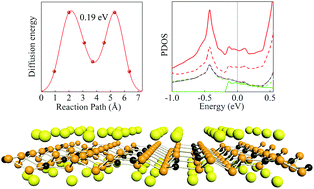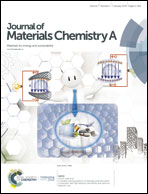Metallic P3C monolayer as anode for sodium-ion batteries†
Abstract
Sodium-ion batteries (SIBs) have become one of the most promising energy storage devices due to the high abundance and safety of sodium. On the other hand, most of the well-developed technologies in lithium-ion batteries (LIBs) can be migrated to SIBs. However, unfortunately, the known anode materials are not suitable in SIBs as a result of the larger atomic radius of sodium compared with lithium. Phosphorus demonstrates an unprecedented high theoretical capacity in SIBs, but its inherent low electrical conductivity and huge volume expansion upon sodiation greatly restrict the cycle stability. Two-dimensional materials as electrodes have shown unique advantages in contrast to their bulk counterparts. In this work, we identify a hitherto unknown P3C monolayer with a puckered honeycomb structure through first-principles swarm-intelligence structure calculations. More intriguingly, the predicted theoretical capacity of P3C as an anode for SIBs is up to 1022 mA g h−1, corresponding to a stoichiometry of P3CNa4. Metallic P3C and P3CNa4 can provide good electrical conductivity during the battery cycle. The acceptable barrier energy and lower open-circuit voltage ensure good rate capacity and safety in practical applications. Its outstanding performance is attributed to the unique arrangement of two kinds of hexagon rings (i.e. P6 and P4C2), producing high cohesive energy and thermodynamic stability. These desirable properties render P3C monolayers as a promising two-dimensional material for application in SIBs.



 Please wait while we load your content...
Please wait while we load your content...